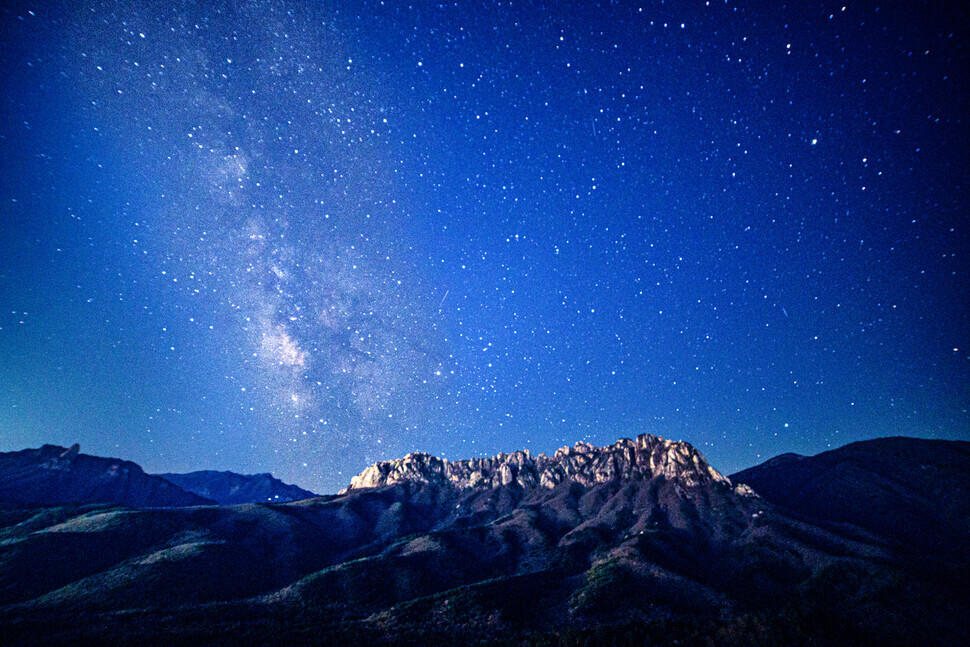hankyoreh
Links to other country sites 다른 나라 사이트 링크
[Korea travels] Korea’s best stargazing spots put the Milky Way almost in reach

I took a trip deep into the woods. Emerging from the toll gate, I drove down a narrow winding road for some time. When I’d almost reached the top of the mountain, I was surprised to find a small village. And just when I was wondering if I was on the right road, I was dumbfounded by the scenery around me. The sun had just begun to set over a wide ridge of mountains that rose to meet the sky.
First village under the heavensHave you ever seen the Milky Way? The Korean word for “Milky Way” literally means “silver river,” as the tens of billions of stars in our galaxy are spread out in a band resembling a river of silver.
From the many folktales about the Milky Way, we can see that humankind has long admired it.
In Greek mythology, the Milky Way was said to have formed after Zeus offered his wife Hera’s breast to the infant Hercules to suckle on while she was sleeping. Even in her deep sleep, Hera was startled awake by Hercules’s enormous strength. She pushed him away, and the milk that spurted from her bosom formed the Milky Way up in the heavens and the white blossoms of the iris on Earth.
The romance of mythology is obviously nothing like reality. But it is this unreal, mythical beauty that inspires such longing in people to see the Milky Way. People venture as far afield as Mongolia or other remote destinations — as distant from the city as possible — just to view it.
As an administrative region, Anbandegi is part of the eastern city of Gangneung. But it juts out from the Daegwal Pass interchange in Pyeongchang. Its location puts it on the boundary between Gangneung and Pyeongchang.
As you travel beyond the vicinity of Yongpyong Resort, the road narrows from two lanes in either direction and becomes a real rural road, without a streetlight to be found.
At Pideok Pass in particular, there is a roughly 3-kilometer stretch that is quite steep and just wide enough for a single car to travel. Drivers here have to pay very close attention.
Located on a rugged ridge of the Taebaek Mountains at an altitude of 1,100 meters, this area is like one big cabbage field. The name “Anbandegi” comes from a combination of the local Gangneung terms “anban,” referring to a broad, concave wooden board used for pounding rice cakes, and “degi,” meaning flat ground.
It’s said to be the size of some 300 football fields, which is difficult to get a sense of. In the mid-1960s, slash-and-burn farmers arrived at this sprawling mountaintop site and tilled the fields themselves with cattle and pickaxes. The farmland they cultivated is now said to be South Korea’s largest high-altitude cabbage field.

A good place to see the Milky Way in Anbandegi is right across from the Meonge Observatory. Watching shutterbugs creep in as night begins to fall, you get the impression that this is considered something of a premier site for viewing the galaxy. I myself opened up a folding chair I’d brought with me and sat back to enjoy the show.
I went up to the small pavilion to see the orange hues of the setting sun, while also gazing out at the wind turbines that kept slowly turning, heedless of the passage of time. At that moment, the lights of the village below seemed particularly tiny. Each time I caught their twinkle, my heart felt full.
Atop a mountain, night is far chillier than it is in the city. I took out the thick layers of clothing that I’d packed for my trip.
As the blackness of night descended, twinkling stars began appearing in the sky. I could hear the slow shutter sounds of cameras mounted on tripods.
Appearing faintly at first, the Milky Way grew denser with time as it started to embroider the night sky. Some of the people were lying on the roof of their car. I was so spellbound by the sky that I spent the whole night taking in the galaxy’s beauty.

Whenever I’m asked which place in Korea offers the most beautiful view of the Milky Way, my answer is immediate: Ulsan Rock in Sokcho.
Historically, the most beautiful places in the world have always been in inaccessible locales. That may be what makes us yearn for them so much.
So it was with the sight of the Milky Way from the old road at Misi Pass. Perhaps the same can be said for the Ladakh region in India, where the galaxy seemed to have been magnified by 20 times behind the mountain ridge — or the Eagle’s Nest in the Pakistani valley of Hunza.
Combining an exotic quality with a characteristically Korean terrain, Ulsan Rock is certainly a sight to behold, radiating exquisite charm. The best way to see it is a drive along the old Misi Pass road. The scenery here is superb, and a drive through it has always helped relax me when I’ve felt frustrated — but it’s quite remote geographically, and you have to be careful navigating the treacherous roads.
It’s so deep in the mountains that there really isn’t anywhere to grab a coffee or a bite to eat. When it snows or rains heavily, the road gets closed down altogether. Even so, I’ve taken trips to Misi Pass from time to time when I’ve felt worn down by the grind of urban living.
I’ve enjoyed car picnics since discovering a site one day where the view of Ulsan Rock was astonishingly good. With the lovely scenery, warm sunshine, few visitors, and tranquil ambience, I remember one time when I shouted for joy in my car here before dozing off.
I’m not sure how much time had passed, but when I woke up, it was already dark. The Milky Way had begun its reveal faintly outside my trunk. I was delighted at this unexpected arrival, and I ended up spending the night there.
Another time, I took a small two-person tent up into a nearby forest and bivouacked there. It’s a setting that scarcely gets any visitors at all, and I would treat it like my own little hideaway, which I visited each year to spend some time whenever Milky Way viewing season rolled around.
Since last summer, however, it’s been possible for everyone to enjoy camping with a view of Ulsan Rock without going through all that effort.
The Camping Neuru campground opened not long ago, so its facilities are quite clean. It also offers a coffee shop and B&B in addition to camping, allowing visitors to enjoy Ulsan Rock in different ways. A particular bonus is its location right next to Misilyeong Valley, which means you can also enjoy some swimming in the summertime.
Must-have appThe best times to look at the Milky Way are roughly between April and September. The rainy season from late June to July is not good viewing weather, so those who’d like to camp under the stars are advised to plan for a visit either between early April and mid-June or between August and September.
Make sure to avoid nights with a full moon. The stars are difficult to make out when the night sky is too bright. The best nights to see the Milky Way and other stars are when the sky is clear and there’s no moon.
You can check the state of the moon with an application called “Phases of the Moon.” You can also reduce your chances of making the trek in vain if you do a search for Milky Way observation times by time of year.
By Hong Yu-jin, travel writer
Please direct questions or comments to [english@hani.co.kr]

Editorial・opinion
![[Guest essay] Preventing Korean Peninsula from becoming front line of new cold war [Guest essay] Preventing Korean Peninsula from becoming front line of new cold war](https://flexible.img.hani.co.kr/flexible/normal/500/300/imgdb/original/2024/0507/7217150679227807.jpg) [Guest essay] Preventing Korean Peninsula from becoming front line of new cold war
[Guest essay] Preventing Korean Peninsula from becoming front line of new cold war![[Column] The state is back — but is it in business? [Column] The state is back — but is it in business?](https://flexible.img.hani.co.kr/flexible/normal/500/300/imgdb/original/2024/0506/8217149564092725.jpg) [Column] The state is back — but is it in business?
[Column] The state is back — but is it in business?- [Column] Life on our Trisolaris
- [Editorial] Penalties for airing allegations against Korea’s first lady endanger free press
- [Editorial] Yoon must halt procurement of SM-3 interceptor missiles
- [Guest essay] Maybe Korea’s rapid population decline is an opportunity, not a crisis
- [Column] Can Yoon steer diplomacy with Russia, China back on track?
- [Column] Season 2 of special prosecutor probe may be coming to Korea soon
- [Column] Park Geun-hye déjà vu in Yoon Suk-yeol
- [Editorial] New weight of N. Korea’s nuclear threats makes dialogue all the more urgent
Most viewed articles
- 1Behind-the-times gender change regulations leave trans Koreans in the lurch
- 2South Korean ambassador attends Putin’s inauguration as US and others boycott
- 3Yoon’s revival of civil affairs senior secretary criticized as shield against judicial scrutiny
- 4Family that exposed military cover-up of loved one’s death reflect on Marine’s death
- 5Hybe-Ador dispute shines light on pervasive issues behind K-pop’s tidy facade
- 6[Guest essay] Preventing Korean Peninsula from becoming front line of new cold war
- 7Yoon’s broken-compass diplomacy is steering Korea into serving US, Japanese interests
- 8Japan says its directives were aimed at increasing Line’s security, not pushing Naver buyout
- 91 in 10 marriages in Korea last year was with a foreign national
- 10[Editorial] New weight of N. Korea’s nuclear threats makes dialogue all the more urgent